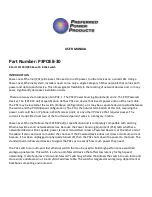
USER MANUAL
Part Number: P3POE8-30
8 Port 10/100/1000 Base-TX 8 PoE Switch
INTRODUCTION
Power-over-Ethernet (PoE) eliminates the need to run DC power to other devices on a wired LAN. Using a
Power-over-Ethernet system, installers need to run only a single Category 5 Ethernet cable that carries both
power and data to each device. This allows greater flexibility in the locating of network devices and, in many
cases, significantly decreases installation costs.
There are two system components in PoE: 1. The PSE (Power Sourcing Equipment) and 2. The PD (Powered
Device). The IEEE 802.3af/at specification defines PSE as a device that inserts power onto an Ethernet cable.
The PSE may be located at the switch (Endspan configuration). or it may be a separate device located between
the switch and the PD (Midspan configuration). The PD is the natural termination of this link, receiving the
power, and could be an IP phone, a WLAN access point, or any other IP device that requires power. The
current is transmitted over two of the four twisted pairs of wires in a Category-5 cable.
Power-over-Ethernet follows the IEEE 802.3af/at specification and is completely compatible with existing
Ethernet switches and networked devices. Because the Power Sourcing Equipment (PSE) tests whether a
networked device is PoE-capable, power is never transmitted unless a Powered Device is at the other end of
the cable. It also continues to monitor the channel. If the Powered Device does not draw a minimum current
because it has been unplugged or physically turned off, then the PSE shuts down the power to that port. The
standard permits Powered Devices to signal the PSEs as to exactly how much power they need.
The PoE switch is a multi-port fast ethernet switch that can be used to build high-performance switched
workgroup networks. This switch is a store-and-forward device that offers low latency for high-speed
networking. It also features a “store-and-forward” switching scheme that allows the switch to auto-learn and
store source addresses in a 1K-entry MAC address table. The switch is targeted at workgroup, department or
backbone computing environments.























